Installation works
Louise Harris – pletten
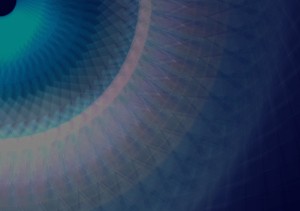 pletten is a dual-screen audiovisual work that is intended for playback on two opposite walls of a dark, square space but can also be exhibited side by side. The work is an exploration of simultaneous compositional process and the development of complementary sonic and visual forms on a micro- and macro- structural level. Ideally, the two screens should be displayed opposite one another, with the audience situated in the centre of the two, allowing them to engage with the sonic and visual structures being formed in a variety of ways, both within the work itself and in the way the work behaves in a confined space.
pletten is a dual-screen audiovisual work that is intended for playback on two opposite walls of a dark, square space but can also be exhibited side by side. The work is an exploration of simultaneous compositional process and the development of complementary sonic and visual forms on a micro- and macro- structural level. Ideally, the two screens should be displayed opposite one another, with the audience situated in the centre of the two, allowing them to engage with the sonic and visual structures being formed in a variety of ways, both within the work itself and in the way the work behaves in a confined space.
Biography
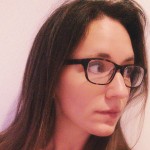 Louise Harris is an electronic and audiovisual composer. She is also a Lecturer in Sonic and Audiovisual Practices at The University of Glasgow. Louise specialises in the creation of audiovisual relationships utilising electronic music and computer-generated visual environments.
Louise Harris is an electronic and audiovisual composer. She is also a Lecturer in Sonic and Audiovisual Practices at The University of Glasgow. Louise specialises in the creation of audiovisual relationships utilising electronic music and computer-generated visual environments.
Disinformation – The Analysis of Beauty
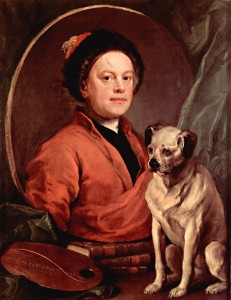 The Analysis of Beauty is a sound and light installation by the art project Disinformation, which takes its title from the book of the same name, published by the artist William Hogarth in 1753. In his book William Hogarth explored the imagery, aesthetics and symbolism of the waving, curved, or (as Hogarth put it) “Serpentine” line, also referred to as the “Line of Beauty and Grace” in the self-portrait Hogarth painted in 1745, lines which in modern language we refer to as sine-waves. In “The Analysis of Beauty” installation, musical sine-waves are visualised on the screen of a laboratory oscilloscope, manifesting as a slowly rotating rope-like pattern of phosphorescent green lines, which strongly (albeit subjectively) resemble DNA (and the installation was first exhibited at Kettle’s Yard gallery, Cambridge, in 2000, alongside works by Umberto Eco, Marc Quinn, and the artist project Art & Language, and directly alongside one of Francis Crick & James Watson’s earliest working-models of DNA). The installation has since been exhibited at The Royal British Society of Sculptors, The Huddersfield Art Gallery and Orleans House Gallery, among others, and toured the UK as the title piece in an Arts Council funded national touring exhibition. Most recently “The Analysis of Beauty” was exhibited at Le Bon Accueil, Rennes, Oct 2014, at the Freud Museum, London, June 2015, and at Talbot Rice, Edinburgh, Nov 2014, where pure low-frequency sine-waves were also fed into a massive 2-storey high 16-channel surround-sound system.
The Analysis of Beauty is a sound and light installation by the art project Disinformation, which takes its title from the book of the same name, published by the artist William Hogarth in 1753. In his book William Hogarth explored the imagery, aesthetics and symbolism of the waving, curved, or (as Hogarth put it) “Serpentine” line, also referred to as the “Line of Beauty and Grace” in the self-portrait Hogarth painted in 1745, lines which in modern language we refer to as sine-waves. In “The Analysis of Beauty” installation, musical sine-waves are visualised on the screen of a laboratory oscilloscope, manifesting as a slowly rotating rope-like pattern of phosphorescent green lines, which strongly (albeit subjectively) resemble DNA (and the installation was first exhibited at Kettle’s Yard gallery, Cambridge, in 2000, alongside works by Umberto Eco, Marc Quinn, and the artist project Art & Language, and directly alongside one of Francis Crick & James Watson’s earliest working-models of DNA). The installation has since been exhibited at The Royal British Society of Sculptors, The Huddersfield Art Gallery and Orleans House Gallery, among others, and toured the UK as the title piece in an Arts Council funded national touring exhibition. Most recently “The Analysis of Beauty” was exhibited at Le Bon Accueil, Rennes, Oct 2014, at the Freud Museum, London, June 2015, and at Talbot Rice, Edinburgh, Nov 2014, where pure low-frequency sine-waves were also fed into a massive 2-storey high 16-channel surround-sound system.
Biography
Disinformation is a sound, video and kinetic art project, which, since 1995, produced a series of pioneering experimental music and installation art works, using natural and man-made electromagnetic (radio) noise, radiated by live mains electricity, lightning, industrial and IT hardware, railway and metro (tube) systems, and even the sun. Disinformation has recorded 8 CDs and LPs, performed more than 100 concerts, exhibited in over 40 gallery exhibitions, and been the subject of 15 solo exhibitions. Disinformation published the “R&D2” CD in 1998, featuring Very Low Frequencyradio noise from Eurostar trains, and the “Sense Data & Perception” CD in 2005, featuring VLF noise from the London Underground system and from Network South East trains.
The “National Grid” sound work was first performed and published on LP in 1996, and first exhibited as a gallery installation in 1997. A huge interactive sound and light installation, since re-titled “The Origin of Painting”, premiered at The Hayward Gallery in 2000. “Fire in the Eye” premiered in 2007, “Ammonite” in 2009, and “The Portrait of Jean Genet” video installation premiered in 2015. Sci-fi author Jeff Noon wrote in The Independent that “people are fascinated by this work”, and Disinformation exhibits have been described as “visually stunning” by The Metro newspaper, and as “actively thrilling” by The Financial Times. The Metro described Disinformation as “the black-ops unit of the avant garde”, while The Guardian wrote that “Disinformation combine scientific nous with poetic lyricism to create some of the most beautiful installations around”.
Tom J Clarke – Sounds for Virtual Spaces
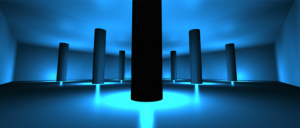 A three part sound art installation immersing listeners in an exploration of audio placement within virtual environments.
A three part sound art installation immersing listeners in an exploration of audio placement within virtual environments.
1. Alloy: Move between mechanical polyrhythms and shuffling samples within this virtual environment.
2. Cabin: Creep amongst the haunting sounds of the cabin inside this randomised horror influenced space.
3. Therapy: Modulate between gliding frequencies and binaural beats in this interactive pitch based installation.
Biography
Tom J Clarke is a composer and sound designer, working within video games, film, dance, and installations.
Tom’s skills are diverse, adapting to the requirements of the work and the needs of his collaborators.
His work seeks to form dialogue between music/ sound and visual materials, with a focus upon immersion and interaction.
Grayson Cooke, Dugal McKinnon – This Storm is Called Progress
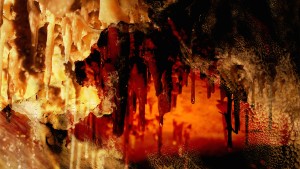 This Storm is Called Progress is a dual-screen audio-visual installation, a collaboration between Grayson Cooke and Dugal McKinnon. Cooke’s footage of the Naracoorte Caves in South Australia is juxtaposed against time-lapse video of Landsat satellite images of Antarctic ice shelves, and acoustically framed by McKinnon’s electronic score. The project pits the “deep time” of ancient geological formations against the time of the present, a technologically amplified time exemplified by the speeding-by of satellite images of ice shelves. The title of this project is derived from Walter Benjamin’s “angel of history”, a tragic figure caught in the storm of progress, forced to unerringly witness the catastrophe of history.
This Storm is Called Progress is a dual-screen audio-visual installation, a collaboration between Grayson Cooke and Dugal McKinnon. Cooke’s footage of the Naracoorte Caves in South Australia is juxtaposed against time-lapse video of Landsat satellite images of Antarctic ice shelves, and acoustically framed by McKinnon’s electronic score. The project pits the “deep time” of ancient geological formations against the time of the present, a technologically amplified time exemplified by the speeding-by of satellite images of ice shelves. The title of this project is derived from Walter Benjamin’s “angel of history”, a tragic figure caught in the storm of progress, forced to unerringly witness the catastrophe of history.
Biographies
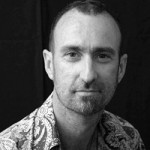 Born in New Zealand and based in Australia, Grayson Cooke is an interdisciplinary scholar and award-winning media artist, Associate Professor of Media in the School of Arts and Social Sciences at Southern Cross University. Grayson has presented live audio-visual performance works in Australia and internationally, and he has exhibited and performed in major international festivals such as the Japan Media Arts Festival, the WRO Media Art Biennale, the Imagine Science festival in New York, and the FILE Festival in Sao Paulo. As a scholar, he has published over 25 academic articles in print and online journals. He is also an associate editor for the online peer-reviewed journal Transformations. He holds an interdisciplinary PhD from Concordia University in Montreal.
Born in New Zealand and based in Australia, Grayson Cooke is an interdisciplinary scholar and award-winning media artist, Associate Professor of Media in the School of Arts and Social Sciences at Southern Cross University. Grayson has presented live audio-visual performance works in Australia and internationally, and he has exhibited and performed in major international festivals such as the Japan Media Arts Festival, the WRO Media Art Biennale, the Imagine Science festival in New York, and the FILE Festival in Sao Paulo. As a scholar, he has published over 25 academic articles in print and online journals. He is also an associate editor for the online peer-reviewed journal Transformations. He holds an interdisciplinary PhD from Concordia University in Montreal.
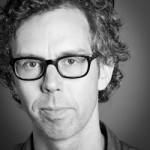 Dugal McKinnon is a composer and sound artist whose output encompasses electronic, acoustic and text media, and is often located at the intersection of these. Recent projects include Let x =, for multichannel sound and icosahedral loudspeaker, created while 2014 artist-in-residence at the Institute for Electronic Music and Acoustics (Graz, Austria), and Lost Oscillations, a collaborative sound installation centred on a custom touch-based interface through which participants explore the layered sonic archeology of Christchurch (NZ). Dugal teaches composition, sonic art and sound studies at Te Kōkī New Zealand School of Music, where he is director of the Lilburn Studios for electronic music.
Dugal McKinnon is a composer and sound artist whose output encompasses electronic, acoustic and text media, and is often located at the intersection of these. Recent projects include Let x =, for multichannel sound and icosahedral loudspeaker, created while 2014 artist-in-residence at the Institute for Electronic Music and Acoustics (Graz, Austria), and Lost Oscillations, a collaborative sound installation centred on a custom touch-based interface through which participants explore the layered sonic archeology of Christchurch (NZ). Dugal teaches composition, sonic art and sound studies at Te Kōkī New Zealand School of Music, where he is director of the Lilburn Studios for electronic music.
Alexander Peverett – Reality Television
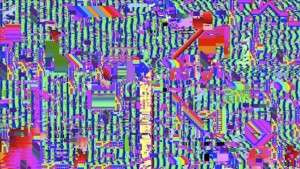 Reality Television is one permutation of a series of identically titled synthetic procedural audio-visual works that each form part of a longer study.
Reality Television is one permutation of a series of identically titled synthetic procedural audio-visual works that each form part of a longer study.
Reality Television is born from an exploration of automated raster graphics painting, direct video synthesis, image processing, human-computer interaction and modular audio-visual synthesis to create systems based extended-duration non-representational direct art.
The correlations between sound and image are not immediately apparent, and although the foundation for the formation of both stem from the same system, each is further developed by processes analogous to each other before reconnecting within the experience of the viewer/listener. All content is generated synthetically through experimentation with generative composition, modular synthesis systems, human and computer controlled video paint boxes, semigraphics and colour cycling techniques.
Throughout the experiments that underlie the development of these works there is focus on the dialogue between computer and artist, a feedback system of progressive learning where the idiosyncrasies and tendencies of coded systems inform the human gestural input and vice versa.
The custom analogue-digital hybridized system that generates the final composite work from its component parts, once initiated, runs indefinitely, progressing through a near infinite number of permutations of abstract audio-visual composition, each section is presented as Reality Television.
Biography
Alexander Peverett (b.1976) is a multi-disciplinary artist from Wigan, England. He resides in Japan and the United Kingdom. His personal work explores the fields of electronic & computer music, video art, multi-media installation, generative art and computer graphics. He has presented work at festivals and galleries including; Lovebytes, ISEA, Sonar, The National Review of Live Arts, Bios, All Tomorrows Parties, New York’s Museum of the Moving Image, Tate Modern, Centre Pompidou, Sendai Mediatheque and Los Angeles Museum of Contemporary Art.
Darrin Martin – Disembody Electric
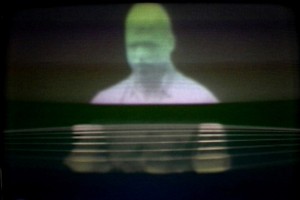 A indexical self portrait disrupted by its analog kin, Disembody Electric is a 28-minute loop of a 3D scan of the artist which has been altered through the use of a wobbulator, an altered CRT (cathode-ray tube) originally invented by Nam June Paik and engineer Shuya Abe in the 1970s. Produced utilizing a recent rendition of the device at Signal Culture, a media arts residency in Upstate NY, Dismbody Electric uses altered electronic frequencies via oscillators that become audible while simultaneously effecting the stability of the image on the screen.
A indexical self portrait disrupted by its analog kin, Disembody Electric is a 28-minute loop of a 3D scan of the artist which has been altered through the use of a wobbulator, an altered CRT (cathode-ray tube) originally invented by Nam June Paik and engineer Shuya Abe in the 1970s. Produced utilizing a recent rendition of the device at Signal Culture, a media arts residency in Upstate NY, Dismbody Electric uses altered electronic frequencies via oscillators that become audible while simultaneously effecting the stability of the image on the screen.
Biography
Darrin Martin is an artist and educator born in New York. His artworks engage the synesthetic qualities of perception by exploring tactile, audible, and visual phenomena through video, sculpture, and print-based installations. Influenced by his own experiences with hearing loss, his current projects consider notions of accessibility through the use of tactility, sonic analogies, and audio descriptions. His works have screened at the Museum of Modern Art (NY); Pacific Film Archive (CA); Impakt Festival (Netherlands); European Media Art Festival (Germany), and many others. His installations have exhibited at venues including The Kitchen (NY), University of Toronto (Canada), Grand Central Art Center (CA), and, most recently, in solo exhibitions at Aggregate Space Gallery (CA), Art Space on Main (CA), and Art & Design Gallery (KS).
Martin received his art degrees from Alfred University’s School of Art and Design (BFA) and University of California, San Diego (MFA). He has held artist residencies at Cite Internationale des Arts, Eyebeam, Experimental Television Center, and Signal Culture. Martin also occasionally curates video screenings and is an Associate Professor in the Department of Art and Art History at University of California, Davis. He lives in San Francisco, CA.
Larry Cuba – Two Space (special MediaWall edition)
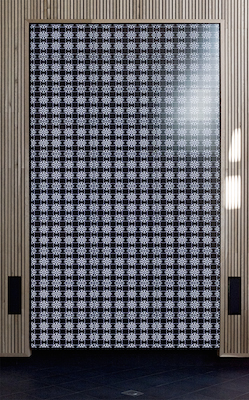 Two dimensional patterns, like the tile patterns of Islamic temples, are generated by performing a set of symmetry operations (translations, rotations, and reflections) upon a basic figure or tile.
Two dimensional patterns, like the tile patterns of Islamic temples, are generated by performing a set of symmetry operations (translations, rotations, and reflections) upon a basic figure or tile.
Two Space consists of twelve such patterns produced using each of nine different animating figures (12 x 9 = 108 total). Rendered in stark black and white, the patterns produce optical illusions of figure-ground reversal and afterimages of color. Gamelan music from the classical tradition of Java adds to the mesmerizing effect.
Two Space was originally produced in 1979 as a 16mm film, using a DEC PDP-10 mainframe computer and a vector graphics film plotter. In 2009, on its 30th anniversary, Two Space was digitised and its soundtrack upgraded to high fidelity stereo. This new digital version can be resized to any required format from Bath Spa University’s MediaWall (shown here) to a Planetarium’s Full Dome Screen.
Biography
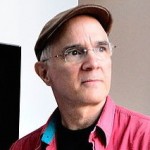 Larry Cuba, a pioneer in computer art, produced his first computer-animated film in 1974. The following year, Cuba collaborated with John Whitney, Sr. programming the film, Arabesque.
Larry Cuba, a pioneer in computer art, produced his first computer-animated film in 1974. The following year, Cuba collaborated with John Whitney, Sr. programming the film, Arabesque.
Cuba’s subsequent computer-animated films, 3/78 (Objects and Transformations) , Two Space, and Calculated Movements, have been screened at film festivals throughout the world—including Los Angeles, Hiroshima, Zagreb and Bangkok—and have won numerous awards. Cuba’s been invited to present his work at conferences on computer graphics and art (such as Siggraph, ISEA, Ars Electronica, Art and Math Moscow, etc.) His films have been included in exhibitions at New York’s Museum of Modern Art, The Whitney Museum, The Hirshhorn Museum, The San Francisco Museum of Modern Art, The Art Institute of Chicago, The Amsterdam Filmmuseum and The Pompidou Center, Paris.
Cuba received fellowship grants from the American Film Institute and The National Endowment for the Arts, and was an artist-in-residence at the Center for Art and Media Technology Karlsruhe (ZKM). He has served on the juries for the Siggraph Electronic Theater, the Siggraph Art Exhibition, The Ann Arbor Film Festival, and Ars Electronica.
In 1994, he founded The iotaCenter, a non-profit organization dedicated to the art of abstract animation and visual music.
John Wedgwood-Clarke, Robert Mackay, Tariq Emam – Resounding Mulgrave (special MediaWall edition)
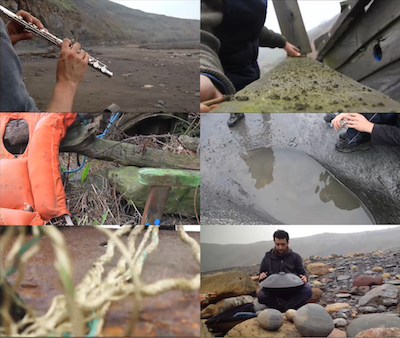 Resounding Mulgrave explores the post-industrial landscape of Port Mulgrave, north of Scarborough, UK. It was one of three artistic interventions exploring and reinterpreting the Rotunda Museum, Scarborough (created by the father of modern Geology, William Smith). It was commissioned by Scarborough Museums Trust as part of the Dictionary Stone project curated by Lara Goodband, and supported by Arts Council England.
Resounding Mulgrave explores the post-industrial landscape of Port Mulgrave, north of Scarborough, UK. It was one of three artistic interventions exploring and reinterpreting the Rotunda Museum, Scarborough (created by the father of modern Geology, William Smith). It was commissioned by Scarborough Museums Trust as part of the Dictionary Stone project curated by Lara Goodband, and supported by Arts Council England.
The work was a collaboration between poet John Wedgwood Clarke and sound artist Rob Mackay, with technical and artistic support from Tariq Emam (video/performance).
‘There’s a fossil shell by my foot the colour and texture of grey opaque glass, perfectly moulded, complete with a scallop’s bow and ridges. Right next to it, but 183 million years later, there’s a limpet. The gap in time between the two doesn’t seem to exist, but I know that it does.’ (John Wedgwood Clarke)
This awareness of the silent, pre-human gap between our present and geological past motivated our exploration of the coast between Port Mulgrave and Staithes. We used words and sound, both found and structured, to play within this silence and make connections between the ‘pastoral’, the ‘sublime’, and the history that has flowed from the smelting of the ironstone for which this stretch of the North Yorkshire coast is geologically famous.
Biographies
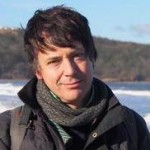 Dr John Wedgwood Clarke lectures in creative writing at the University of Hull. In 2012/13 he was Leverhulme Poet in Residence in the marine biology department at the University of Hull. He regularly works with curators, scientists and artists on public art projects and is currently completing an Arts Council-funded writing project about rubbish. His first full collection Ghost Pot (2013) was described as ‘a masterpiece that deserves continual rereading’ by Bernard O’Donoghue. Recent poems have appeared in PN Review, Poetry Review, POEM, The New Statesman, Oxford Poetry, Best British Poetry 2012 and Poetry Wales.
Dr John Wedgwood Clarke lectures in creative writing at the University of Hull. In 2012/13 he was Leverhulme Poet in Residence in the marine biology department at the University of Hull. He regularly works with curators, scientists and artists on public art projects and is currently completing an Arts Council-funded writing project about rubbish. His first full collection Ghost Pot (2013) was described as ‘a masterpiece that deserves continual rereading’ by Bernard O’Donoghue. Recent poems have appeared in PN Review, Poetry Review, POEM, The New Statesman, Oxford Poetry, Best British Poetry 2012 and Poetry Wales.
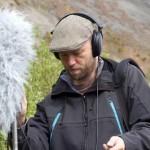 Rob Mackay is a composer, sound artist and performer. Currently he is a Senior Lecturer in Creative Music Technology at the University of Hull. Recent projects have moved towards a cross-disciplinary approach, including geology, soundscape ecology, theatre, audiovisual installation work, and human-computer interaction. His work has been performed in 18 countries (including several performances on BBC Radio 3, BBC Radio 1 and Radio France), and a number of his pieces have received international awards (Bourges, EAR, Confluencas, La Muse en Circuit). He has held composer residencies at Slovak Radio (Bratislava), La Muse en Circuit (Paris), the Tyrone Guthrie Arts Centre (Ireland), Habitación del Ruido (Mexico City), and CMMAS (Morelia).
Rob Mackay is a composer, sound artist and performer. Currently he is a Senior Lecturer in Creative Music Technology at the University of Hull. Recent projects have moved towards a cross-disciplinary approach, including geology, soundscape ecology, theatre, audiovisual installation work, and human-computer interaction. His work has been performed in 18 countries (including several performances on BBC Radio 3, BBC Radio 1 and Radio France), and a number of his pieces have received international awards (Bourges, EAR, Confluencas, La Muse en Circuit). He has held composer residencies at Slovak Radio (Bratislava), La Muse en Circuit (Paris), the Tyrone Guthrie Arts Centre (Ireland), Habitación del Ruido (Mexico City), and CMMAS (Morelia).
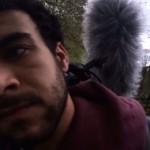 Tariq Emam is researching towards a PhD in Music by Composition at the University of Hull having been awarded one of the institution’s first interdisciplinary PhD scholarships. He is working with the soundscape of the Yorkshire Dales, grounding his work on an archive of sounds recorded there 40 years ago. By merging old and new data he aims to develop a soundscape monitoring system that evokes both the natural and anthropogenic environment. Alongside academia he works as a filmmaker and A/V technician, collaborating with varieties of artists and organisations and plays music in the form of percussion, noise, and the Hang. Tariq currently lives in York.
Tariq Emam is researching towards a PhD in Music by Composition at the University of Hull having been awarded one of the institution’s first interdisciplinary PhD scholarships. He is working with the soundscape of the Yorkshire Dales, grounding his work on an archive of sounds recorded there 40 years ago. By merging old and new data he aims to develop a soundscape monitoring system that evokes both the natural and anthropogenic environment. Alongside academia he works as a filmmaker and A/V technician, collaborating with varieties of artists and organisations and plays music in the form of percussion, noise, and the Hang. Tariq currently lives in York.
Ellis Sharpe – Push
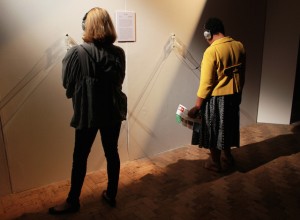 Ellis Sharpe has developed a premise for creating interactive, audio-descriptive paintings that do not exist in physical space. In Sharpe’s thought experiments, his audience is confronted with a choice of whether or not to participate.
Ellis Sharpe has developed a premise for creating interactive, audio-descriptive paintings that do not exist in physical space. In Sharpe’s thought experiments, his audience is confronted with a choice of whether or not to participate.
When looking at a painting, a viewer will resort to their imagination as well as their sight. In Sharpe’s work, he invites the viewer to join him in the creative process. The participant’s experience of his audio-descriptive paintings doesn’t begin with listening and end with the visual information that is narrated to them. There is often an action that the listener is encouraged to perform. Using a canvas to penetrate through a wall requires the listener to delve further into their imagination in order to fully engage with the work. The participatory aspects of these paintings enable the audience to reflect upon their autonomy through personal experience, diminishing the gap between artist, viewer and subject.
Biography
Ellis Sharpe is currently undertaking an MA in Art Psychotherapy at Goldsmiths University of London. He previously studied Fine Art at Nottingham Trent University and has exhibited his work across the UK and internationally. Sharpe’s transition from physical paintings to hypothetical images was fuelled by his research into psychotherapy. The recent audio-descriptive paintings provide us with an opportunity to project our thoughts and experiences onto the work, and reflect on its meaning within our own frame of reference.
Chris Plant – Frequency Response #2
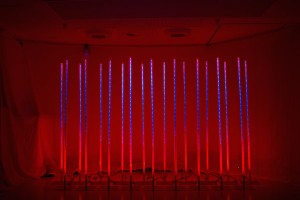 An investigation into colour perception through the use of colour fields and red, green and blue light frequencies dropped to audible tones, to see if hearing the colours can amplify or reinforce our perceptions, and our emotional or conscious perception of light.
An investigation into colour perception through the use of colour fields and red, green and blue light frequencies dropped to audible tones, to see if hearing the colours can amplify or reinforce our perceptions, and our emotional or conscious perception of light.
Initially created for the International Year of Light 2016 as an artist residency in the Photonics Dept. of Aston University and in conjunction Flatpack Festival.
Biography
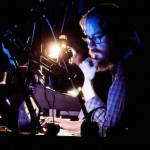 Chris Plant has been creating live visuals since 1991, under the name Catweasel. Starting out animating by hand drawing on 16mm film and creating hand made slides, progressing through scratch video editing to AfterFx, VJing and into his current strand of practice creating realtime light and video installations mostly incorporating vvvv programming. Other current investigations after 15 years of mostly programming are hardware video synths and analogue light effects, the circle continues.
Chris Plant has been creating live visuals since 1991, under the name Catweasel. Starting out animating by hand drawing on 16mm film and creating hand made slides, progressing through scratch video editing to AfterFx, VJing and into his current strand of practice creating realtime light and video installations mostly incorporating vvvv programming. Other current investigations after 15 years of mostly programming are hardware video synths and analogue light effects, the circle continues.
www.colour-burst.com
@_cat_weasel
Aural-i – Play the Building’s Soul
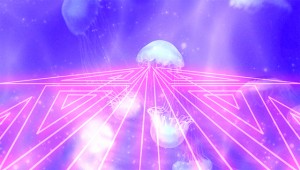 Play the Building’s Soul is a site-specific audio-visual installation performance for the Creative Commons building at Newton Campus. It consists of a MIDI instrument that projects audiovisual objects onto the facade of the building. Sounds will be gathered from around the building and these will be processed and represented by short animations or abstract photographs. These will be then programmed onto a MIDI interface for a multi-sensory, immersive performance. Using projection mapping techniques and surround sound design, AURAL-I will turn the building inside out.
Play the Building’s Soul is a site-specific audio-visual installation performance for the Creative Commons building at Newton Campus. It consists of a MIDI instrument that projects audiovisual objects onto the facade of the building. Sounds will be gathered from around the building and these will be processed and represented by short animations or abstract photographs. These will be then programmed onto a MIDI interface for a multi-sensory, immersive performance. Using projection mapping techniques and surround sound design, AURAL-I will turn the building inside out.
Biographies
Aural-I is a Bristol and Bath collective of audio-visual artists creating projection-mapping installations for festivals and urban settings. Formed in 2015, they projected animations inspired by the unique architecture of the 77 Stokes Croft Building in central Bristol for the Arts Weekender festival in October last year. Their work for Seeing Sound is their follow-up commission.